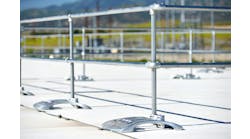As dangerously cold temperatures have swept through the Midwest and Northeast, many schools in the affected area cancelled classes in light of the extreme temperatures. The University of Iowa, for example, cancelled all classes for the first time since December 2009, while Iowa State University is observing its first closing since 2014.
But suspending classes for a couple of days is just the tip of the iceberg when it comes to keeping students safe during a deep freeze.
Here are five things you can do right now to mitigate the polar vortex’s impacts on your campus.
1. Master Your Mass Communication
Use texts for one- to two-sentence missives – for example, “All classes are cancelled from 4 p.m. Tuesday until noon Thursday” – and include a shortened link to more detailed instructions on your website. Issue details by email too, since students are likely to check there before they think to look at your website.
Longer messages should emphasize the importance of being prepared. Frostbite and hypothermia can develop in as little as 5 minutes when the wind chill is this severe.
2. Create Cold Prep Tips
Not everyone at your institution is used to cold weather. International students and out-of-state students from warmer climates may have underestimated how cold winter can get, especially during a period as severe as this one. Make sure your communications include tips on personal safety and taking good care of residence hall rooms.
[Related: 5 Ways to Prepare Buildings for Extreme Cold Temperatures]
“Our hall directors got multiple emails to tell us to keep our windows closed and locked because the wind might be able to push them open more, and if you’re not in the room at the time, you could freeze the pipes,” explains Andrew Grant, a freshman at Iowa State University in Ames, Iowa, majoring in electrical and mechanical engineering. “They’ve been reaching out to us with tips on how to stay safe in dangerous cold weather.”
Students used to warmer weather may benefit from tips on dressing for the weather. Basic instructions like “wear layers” or “wear a warm coat” don’t fully convey the seriousness of the situation to anyone who’s not used to cold winters.
“Invest in a coat that goes down to your knees, if not further,” suggests MacKenzie Male, a junior studying biochemistry at the University of Northern Iowa in Cedar Falls, Iowa. “Coats have different temperature ratings, so get one that is going to be OK for negative degree weather. Hats, scarves, a good pair of gloves and a good pair of shoes to walk in the snow when the sidewalks aren’t completely cleared. You need something that will keep the wind from getting to your skin.”
3. Coordinate with Faculty
Encourage faculty to disseminate their own messages with instructions about each class. Students who expected to take tests or hand in papers this week will want to know what to do, especially if they’re expected to complete readings or assignments during the cancelled classes.
Ryan Downing, a junior at the University of Iowa studying political science, ethics and public policy, noted that one professor recorded a lecture that students will watch instead of physically going to class. Other professors might send out lecture notes or PowerPoint slides or assign extra readings.
For future emergencies that don’t warrant a school-wide closing, Kirkwood Community College sophomore Colin VandeWeerd urges faculty and administrators to consider students who commute to class.
Help BUILDINGS Shape 2019!
What BUILDINGS resources are most valuable to you? What would you like to see us provide?
Please take our short (under 2 minutes) survey - just 5 short questions.
Thank you!
“If the school doesn’t cancel but you think people are going to have a rough time getting to your class or you yourself can’t make it, don’t put yourself in danger,” says VandeWeerd, a liberal arts major at Kirkwood’s Cedar Rapids campus. “Just call off class and have them do something in the book or by email. You could have people getting in pileups on the interstate. Some of that could be prevented if people just stay home.”
4. Publicize Routes and Transportation
Make sure students know the warmest routes around campus. First-year and transfer students will especially appreciate the tips.
Josie Te Grotenhuis, a freshman at Dordt College in Sioux Center, Iowa, recommends “building-hopping,” or taking routes that pass through buildings rather than a more direct route that’s exposed to the cold the entire time. Students with cars can park closer to class buildings if spots are available, Downing notes.
If you have the resources, consider making it easier for students to get across campus even if classes are cancelled.
Central College in Pella, Iowa, notified students about a shuttle between the residence halls, the student center and the main dining area, says Zach Jansen, a Central sophomore studying business and computer science. Some of the residence halls are up to 10 minutes from these important areas, so reliable transportation is vital when frostbite can set in within five minutes.
Schools with skywalks, heated underground tunnels or other sheltered infrastructure may even be able to maintain their regular academic schedule.
Wartburg College in Waverly, Iowa, features skywalks that connect the library and academic buildings. The most distant residence hall is only a 3- to 4-minute walk from the nearest skywalk entrance, so Knights can safely get to class without difficulty, explains freshman Alex Stone, a biology major. Mount Mercy University in Cedar Rapids, Iowa, has underground tunnels connecting buildings.
[Check out: Roof Repairs in Extreme Weather Conditions]
5. Plan for Disadvantaged Students
Not all students have the ability to invest in extra layers for weather that’s colder than they were expecting, Male says. Connect needy students with available resources so that they can get adequate gloves, coats and hats if what they have isn’t warm enough.
“Some students on campus don’t have the proper clothing or proper coats,” Male says. “I don’t know if they can afford them or not, but there are a lot of people who are unprepared for the weather and I don’t think administrators look at all the factors of students maybe not being able to afford things. A good [temperature-rated] coat is going to be well over $200.”
Your students are counting on you to keep them safe, so make decisions based on the best available information and make sure the message gets to everyone who needs it. Staying in close contact and keeping students updated will ensure everyone has the information they need to stay out of harm’s way.
Two handpicked articles to read next:




![Maple Leaf Foods Ontario[2] Maple Leaf Foods Ontario[2]](https://img.buildings.com/files/base/ebm/buildings/image/2022/06/16x9/Maple_Leaf_Foods___Ontario_2_.62a0caaf6297f.png?auto=format,compress&fit=fill&fill-color=white&q=45&h=139&height=139&w=250&width=250)